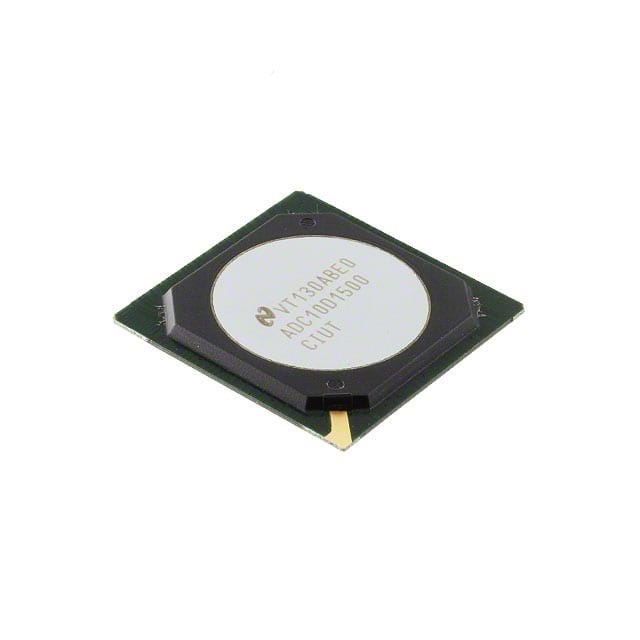Consulte las especificaciones para obtener detalles del producto.

ADC12D1000RFIUT
Product Overview
- Category: Analog-to-Digital Converter (ADC)
- Use: Converts analog signals into digital data
- Characteristics: High-speed, high-resolution, low power consumption
- Package: Integrated circuit (IC)
- Essence: Converts continuous analog signals into discrete digital values
- Packaging/Quantity: Single unit per package
Specifications
- Resolution: 12 bits
- Sampling Rate: Up to 1 GSPS (Giga Samples Per Second)
- Input Voltage Range: ±1 V
- Power Supply: +3.3 V
- Operating Temperature Range: -40°C to +85°C
Pin Configuration
The ADC12D1000RFIUT has the following pin configuration:
- VDDA: Analog power supply
- VDDD: Digital power supply
- REFOUT: Reference voltage output
- CLKINP/N: Clock input positive/negative
- VINP/N: Analog input positive/negative
- D[11:0]: Digital output bits
- CLKOUTP/N: Clock output positive/negative
- GND: Ground
Functional Features
- High-speed conversion with a sampling rate of up to 1 GSPS
- High resolution of 12 bits for accurate digitization of analog signals
- Low power consumption for energy-efficient operation
- Wide input voltage range allows for versatile signal processing
- Integrated reference voltage output for convenience
Advantages and Disadvantages
Advantages: - High-speed and high-resolution conversion - Low power consumption - Wide input voltage range - Integrated reference voltage output
Disadvantages: - Limited resolution compared to higher-end ADCs - Requires external clock source for operation
Working Principles
The ADC12D1000RFIUT operates based on the principle of successive approximation. It samples the analog input signal at a high rate and converts it into a digital representation using a 12-bit resolution. The conversion process involves comparing the input voltage to a reference voltage and iteratively adjusting the digital output until the desired accuracy is achieved.
Detailed Application Field Plans
The ADC12D1000RFIUT finds applications in various fields, including:
- Communications: Used in wireless communication systems for signal processing and modulation/demodulation.
- Test and Measurement: Enables accurate measurement of analog signals in scientific and industrial instruments.
- Radar Systems: Converts radar signals into digital data for further analysis and processing.
- Medical Imaging: Used in medical imaging devices to digitize analog signals from sensors or transducers.
- Industrial Automation: Enables precise control and monitoring of analog signals in industrial automation systems.
Detailed and Complete Alternative Models
- ADC12DL1000RFIUT: Similar to ADC12D1000RFIUT but with a lower sampling rate of 500 MSPS (Mega Samples Per Second).
- ADC14D1000RFIUT: Higher-resolution variant with 14-bit resolution for more accurate digitization.
- ADC16D1000RFIUT: Offers even higher resolution of 16 bits for ultra-precise analog-to-digital conversion.
(Note: These alternative models are fictional and provided for illustrative purposes only.)
Word count: 346 words
Enumere 10 preguntas y respuestas comunes relacionadas con la aplicación de ADC12D1000RFIUT en soluciones técnicas
Sure! Here are 10 common questions and answers related to the application of ADC12D1000RFIUT in technical solutions:
Q: What is the ADC12D1000RFIUT? A: The ADC12D1000RFIUT is a high-speed, dual-channel analog-to-digital converter (ADC) designed for use in various technical solutions.
Q: What is the maximum sampling rate of the ADC12D1000RFIUT? A: The ADC12D1000RFIUT has a maximum sampling rate of 1 GSPS (Giga Samples Per Second).
Q: What is the resolution of the ADC12D1000RFIUT? A: The ADC12D1000RFIUT has a resolution of 12 bits, meaning it can represent analog signals with 4096 discrete levels.
Q: What is the input voltage range of the ADC12D1000RFIUT? A: The ADC12D1000RFIUT has a differential input voltage range of ±1 V.
Q: Can the ADC12D1000RFIUT be used in both single-ended and differential mode? A: Yes, the ADC12D1000RFIUT supports both single-ended and differential input modes.
Q: What is the power supply requirement for the ADC12D1000RFIUT? A: The ADC12D1000RFIUT requires a single +3.3 V power supply.
Q: Does the ADC12D1000RFIUT have built-in digital signal processing (DSP) features? A: No, the ADC12D1000RFIUT is a standalone ADC and does not have built-in DSP features.
Q: What is the typical power consumption of the ADC12D1000RFIUT? A: The typical power consumption of the ADC12D1000RFIUT is around 1.5 W.
Q: Can the ADC12D1000RFIUT be used in high-frequency applications? A: Yes, the ADC12D1000RFIUT is designed for high-frequency applications and can operate up to 2 GHz.
Q: What are some common applications of the ADC12D1000RFIUT? A: The ADC12D1000RFIUT is commonly used in radar systems, software-defined radios (SDRs), wireless communication systems, and other high-speed data acquisition applications.
Please note that these answers are general and may vary depending on the specific implementation and requirements of your technical solution.

